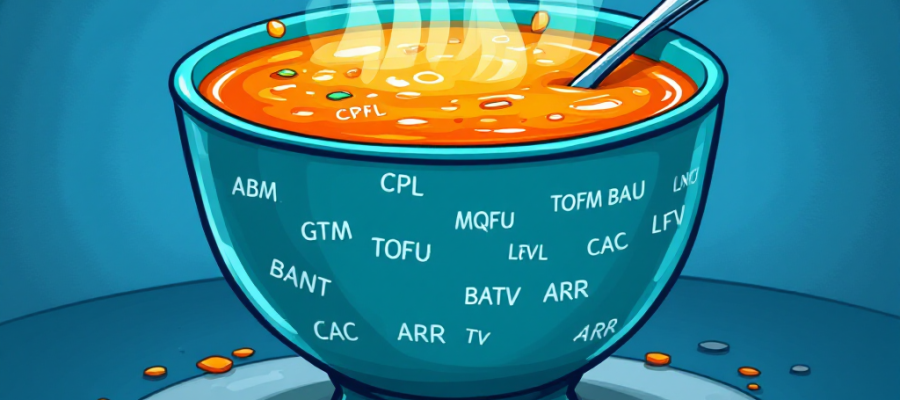
In the fast-paced world of B2B marketing, acronyms dominate conversations, strategies, and day-to-day operations. While they save time and make communication efficient, it’s crucial to fully understand their meaning to ensure clarity and alignment across teams. Whether you’re new to marketing or a seasoned pro, this guide will serve as your cheat sheet for the top 25 acronyms in B2B marketing.
- ABM (Account-Based Marketing)
ABM is a highly targeted marketing strategy where sales and marketing teams work together to identify and engage high-value accounts rather than casting a wide net. Think personalized campaigns for specific accounts.
- GTM (Go-to-Market)
Your GTM strategy is the overarching plan for launching a product or service into the market. It includes all elements of sales, marketing, positioning, and distribution.
- MQL (Marketing Qualified Lead)
An MQL is a lead that has shown interest in your product or service (e.g., downloading a whitepaper or attending a webinar) and is deemed ready for sales engagement based on predefined criteria.
- SQL (Sales Qualified Lead)
A SQL is a lead that has been vetted by both marketing and sales teams and is ready to be pursued by sales. They’ve demonstrated a stronger intent to purchase than an MQL.
- CPL (Cost Per Lead)
CPL measures the cost of acquiring a single lead. It’s a key metric when evaluating the efficiency of lead generation campaigns, including content syndication and paid ads.
- ICP (Ideal Customer Profile)
Your ICP outlines the characteristics of the customers most likely to benefit from your product or service. It includes firmographics like company size, industry, and revenue, as well as behavioral traits.
- ROI (Return on Investment)
ROI measures the profitability of an investment. In B2B marketing, this is often used to evaluate the success of campaigns, tools, or strategies.
- CAC (Customer Acquisition Cost)
CAC calculates the cost of acquiring a new customer, factoring in marketing and sales expenses. Keeping CAC low is essential for sustainable growth.
- NPS (Net Promoter Score)
NPS gauges customer loyalty by asking how likely they are to recommend your product or service. It’s a key indicator of customer satisfaction and brand health.
- TOFU (Top of Funnel)
TOFU refers to the awareness stage of the buyer’s journey, where prospects are just learning about your product or service. Content like blogs, videos, and infographics are common here.
- MOFU (Middle of Funnel)
MOFU is the consideration stage, where prospects are evaluating solutions. Case studies, webinars, and comparison guides are typical content types for this stage.
- BOFU (Bottom of Funnel)
BOFU represents the decision stage, where leads are ready to make a purchase. Content like demos, free trials, and testimonials help close the deal.
- TAM (Total Addressable Market)
TAM is the total revenue opportunity available if your product or service captures 100% of the market share. It’s used to evaluate the scale of an opportunity.
- TAL (Target Account List)
TAL is a curated list of accounts that your ABM strategy targets. These accounts are typically high-value and align closely with your ICP.
- HQL (High-Quality Lead)
Unlike MQLs, HQLs are leads that have shown deeper engagement and are more likely to convert, such as attending a demo or requesting a pricing quote.
- CPL (Cost Per Lead)
CPL is the amount you spend to generate a single lead. It’s a critical metric for evaluating the ROI of content syndication, display ads, and other lead generation tactics.
- ARR (Annual Recurring Revenue)
ARR is a key metric for SaaS and subscription-based businesses. It measures the total recurring revenue generated annually from subscriptions or contracts.
- MRR (Monthly Recurring Revenue)
MRR is the monthly equivalent of ARR and is used to track subscription revenue and growth trends.
- CRM (Customer Relationship Management)
CRM platforms like Salesforce and HubSpot help manage customer data, track interactions, and streamline sales and marketing efforts.
- CPL (Cost Per Lead)
Yes, CPL is so important it’s worth mentioning again! It’s a metric that keeps coming up in B2B marketing because of its focus on efficiency and value generation in lead acquisition.
- DSP (Demand-Side Platform)
DSPs are used to automate the purchasing of digital ads across multiple platforms, enabling efficient, data-driven ad spend allocation.
- BANT (Budget, Authority, Need, Timeline):
A sales qualification framework to evaluate leads developed by IBM in the 1970’s, it can be still used today as a tool to qualify leads or opportunities.
- CTA (Call to Action)
Every piece of B2B marketing content should include a CTA. Whether it’s “Download Now,” “Request a Demo,” or “Contact Sales,” CTAs guide prospects toward the next step in their journey.
- SEO (Search Engine Optimization)
SEO is the practice of optimizing your website and content to rank higher on search engines. It’s a key driver of organic traffic and lead generation.
- PLG (Product-Led Growth)
PLG focuses on letting the product itself drive adoption and growth through free trials, freemium models, or viral features. It’s gaining traction in SaaS as buyers prefer to “try before they buy.”
Bonus Acronyms You Should Know
- ABX (Account-Based Experience): An evolution of ABM that prioritizes customer experience throughout the buyer journey.
- LTV (Lifetime Value): The projected revenue a customer will generate over their lifetime.
- SDR (Sales Development Representative): The team responsible for outbound prospecting and qualifying leads.
Why Do These Acronyms Matter?
B2B marketing is full of jargon, and while acronyms save time, they can also create confusion if teams aren’t aligned on their meaning. Use this guide to not only familiarize yourself with the terminology but also to ensure your sales and marketing teams are speaking the same language. When you understand the acronyms, you understand the strategies—and that’s where the magic happens.
